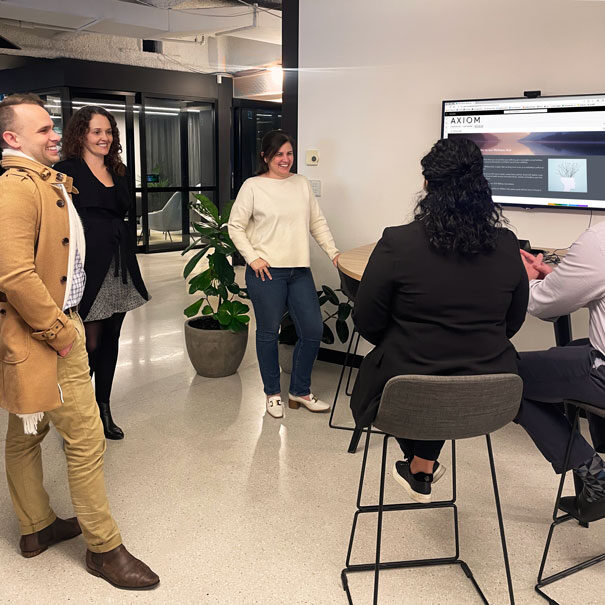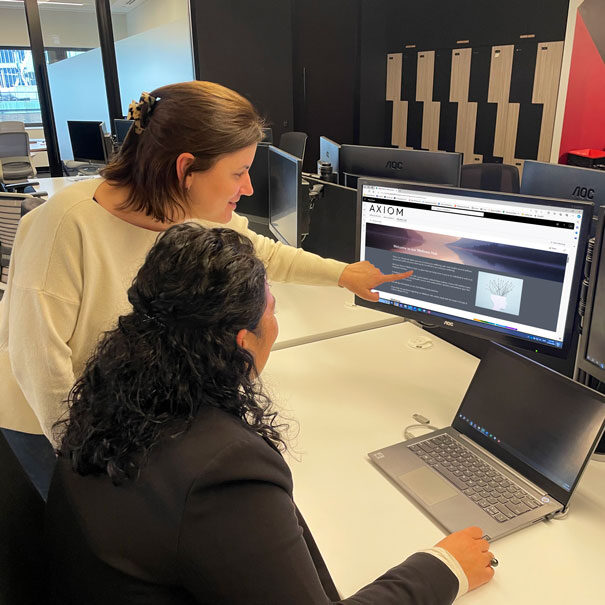
Axiom's Workplace Wellness Program: From Little Things, Big Things Grow

Axiom's Head of People & Culture Team explains how she successfully implemented the workplace wellness program.
The Journey Begins: Mental Health Training
“Bite-sized steps,” is how our Head of People & Culture, responds when asked about the benefits of workplace mental health coaching.
“It doesn’t need to be hours on hours on hours,” she says. “It’s about putting your mind to mental health and wellbeing on a regular basis.”
Seeking Support and Guidance
Rewind a few months and the team had just finished workplace mental health training, delivered by Black Dog Institute and proudly funded by NSW Government.
The training led to an increased appetite for wellbeing initiatives and conversations across the small organisation of 40 employees.
“I wanted to do more, but didn’t know where to start,” she says. “I saw an opportunity for some government funded coaching with a consulting organisational called Transitioning Well and thought, ‘Let’s give it a go’.
Axiom registered and was connected with her free workplace mental health coach, Sarah Alwyn, who helped the team transform her ideas into actionable steps.
“Workplace mental health and wellbeing doesn’t have to be this big, huge audacious thing to tackle,”
Sarah gave Axiom's HR Team insights on how to effectively integrate mental health initiatives into the workplace.
“Sarah brought it back to a point where you could understand what was needed. She broke it into bite sized pieces.”
With Sarah's guidance, Axiom:
- Set clear, achievable short-term goals.
- Held regular check-ins to stay accountable.
- Focused on developing a mental health policy.
Creating a Mental Health Policy
“Getting on the right page around our commitments was a really important step in the development of the mental health policy.”
The HR Team were able to collaborate with senior leadership, and ultimately gain buy-in for the mental health policy.

The Policy's Impact on the Organisation
The mental health policy serves as a catalyst for conversations and provides a clear understanding of our commitments and actions.
“It helps start the conversation ... having that policy is really key because it gives you a clear understanding of what the requirements are and what you can do.”
And now, there's a real shift in the organisation. We started slow and when it clicked, ran fast with it.

Launching the Wellness Hub
The Wellness Hub, a digital content portal that her team launched to support mental health and wellbeing. The Wellness Hub includes:
- Resources and information on mental health.
- Support pathways for staff.
- Confidential access for independent use.
The Wellness Hub is a tool that is used to mitigate or manage identified psychosocial risks in the workplace.
Introducing the Wellness Day Program
We’ve also introduced a Wellness Day Program, giving employees three days annually to focus on their wellness, in addition to their legislative leave. The wellness day allows employees to:
- Take care of their mental health in their own way.
- Return to work more focused and engaged.
- Feel supported by the organisation in their personal wellness journey.
Measuring Success: The Engagement Survey
Perhaps the biggest tool to validate the hard work is our weekly engagement survey.
“Wellness is a whole section on its own, and it’s always been one of our areas of focus.”
Now, she says, it’s already uplifted. In fact, at one point, wellbeing was measuring higher than any of the other indicators.
Ongoing Commitment to Mental Health
“We’ve still got a way to go,” the team acknowledges. “You can’t become complacent around mental health and wellness, it’s just great to see what we are doing is having an impact already.
"There are changes just in the way people are thinking and talking about mental health and wellbeing now.”
For government advice on mental health at work click the link:
https://www.nsw.gov.au/mental-health-at-work/free-training-and-coaching/coaching
Want to know how workplace design & strategy can impact wellness & wellbeing?






